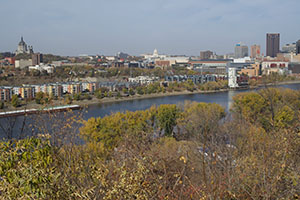Professional Collaboration

We work closely with our community partners and local governments to ensure adequate water supply while addressing pollution sources such as agricultural stormwater runoff. Environmental Services staff regularly engage with water professionals; water-focused nonprofit organizations; federal, state, and local government staff; and residents to hear about regional water values and concerns. Population growth and expanding development are increasing demand on our water supplies in the region, and coordinated planning by local communities, the Met Council, and state partners will help meet our future water supply needs.
 Partnering with local governments to coordinate water planning
Partnering with local governments to coordinate water planning
Under state law, local governments in the seven-county metro area are required to develop a local surface water management plan along with their comprehensive land use plan. In 2022, we collaborated with the Minnesota Board of Water and Soil Resources and watershed organizations to help us understand how we could improve our coordination of and clarify the requirements for these local surface water management plans.
We also gathered input from each subregion to inform draft policies and strategies so we could build the Metro Area Water Supply Plan, which provides a framework for sustainable long-term water supply planning at the local and regional level. Our intent is to support local control and responsibility of water systems and to let each subregion’s needs dictate the direction of the broader water supply planning in the region.
 Fostering an interagency group to address shared water quality concerns
Fostering an interagency group to address shared water quality concerns
Twin Cities Water Monitoring and Data Assessment Group, a regional partnership of water quality experts, continued to grow in 2022 thanks to leadership and commitment of our Water Resources Planning staff. The group helps coordinate and share information about regional water-quality issues facing cities, counties, townships, and watershed groups, as well as state and federal agencies. It establishes and promotes standard practices for water monitoring, analysis, and data stewardship in the metro area.
 MnTAP partnership funds student research on water conservation
MnTAP partnership funds student research on water conservation
The Met Council provides Minnesota Clean Water, Land & Legacy Amendment funds to Minnesota’s Minnesota Technical Assistance Program (MnTAP) to support water conservation activities for industries and businesses in the seven-county metro region. MnTAP offers customized, site-based technical assistance that helps facilities conserve resources, prevent pollution, and reduce costs.
The Met Council/MnTAP collaboration focuses on conducting site assessments and placing summer engineering interns at metro-area businesses. MnTAP technical staff and interns work to map water use, establish maintenance programs that avoid water loss, identify opportunities to use water efficiently, and modify process water use through cost-effective solutions.
In 2022, MnTAP placed Met Council-funded student interns at seven area businesses. These interns identified more than 80 million gallons of potential water savings per year, with an associated $2 million reduction in costs. An additional benefit is the on-the-ground experience these interns receive. More information about all 2022 interns and their successful projects can be found in MnTAP Solutions.
Teacher externship program engages current and future STEM educators
Environmental Services once again partnered with the Minneapolis Regional Chamber of Commerce to host high school educators through the Teacher Externship Program. Approximately 30 science, technology, engineering, and math (STEM) educators from across the metro region participated in the program. The educators toured the Eagles Point Wastewater Treatment Plant and participated in discussions on the future of our workforce. Our staff discussed career options within the division, illustrating our work as a real workplace application of STEM skills. Staff, in turn, learned about the nature of our future workforce, and how our division may better suit the needs of the next generation of employees.